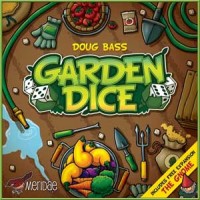
Garden Dice
Overview
Garden Dice offers a unique and fun approach to dice rolling and tile placement games. Each player takes the role of a gardener; planting seeds, watering seeds and then harvesting veggies. You’ll score points for the veggies you harvest during the game and then gain bonus points at the end of the game depending on what sets and collections of veggies you have.
Sounds easy enough, but where it gets tricky is players all share the same garden. This means you won’t always be able to plant where you want, but it also means you can strategically plant your veggies so that other players end up watering and harvesting them for you!
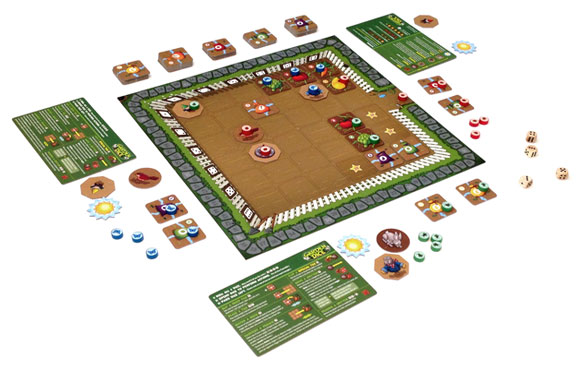
Set Up
Garden Dice is very easy to set up. Simply lay out the board, organize the veggies in piles (the number of each veggie depends on how many players there are) and give each player their discs, special tiles and sun token.
The Garden Board
This is where all the action happens. The garden is made up of a 6×6 grid, and around the grid you’ll see the face of a die next to each row and column, used as coordinates (we’ll explain this more later). One section of the garden has point multipliers, which make these spaces highly desired. Finally, around the edge of the board you have a score track.
Veggie Tiles
There are five different veggies you can plant. Each veggie tile has two sides; the seed side (that you purchase and water) and the veggie side (that you harvest). They also have a number in the corner that tells you how much the veggie costs, and how many points you’ll get when you harvest them.
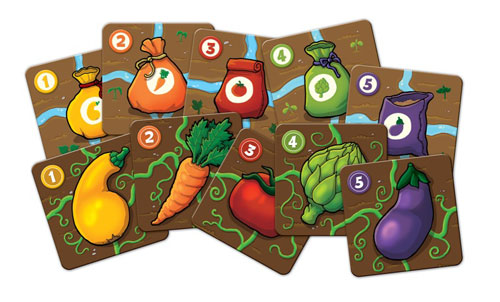
Player pieces
Each player has nine wooden discs. One is used to track their score, and the others are used to track which tiles are theirs. Since you’re limited to eight discs, you can only have that many tiles in play at once (once you harvest a veggie you get your disc back). Each player will also get a bird/rabbit tile, sundial/scarecrow tile and gnome tile. These tiles, when played, let you take special actions during your turn. Finally, each player gets a Sun token. This token lets you manipulate or re-roll your dice one time during the game, or save it for five bonus points at the end of the game.
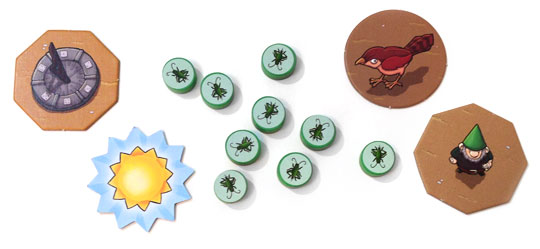
Gameplay
Your turn is very simple; you roll 4 dice, spend them to perform actions, then pass the dice to the player on your left.
How you use the dice is where Garden Dice differentiates itself from most games out there that use the dice rolling mechanic. You can use the values you roll to perform a variety of actions:
- Buy a seed tile (requires one die)
- Place a tile (requires two dice)
- Water a seed (requires one die)
- Harvest a veggie (requires one die)
- Flip a special tile (requires one die)
- Move a critter (requires one die)
- Remove a critter (requires three dice)
You get to use all four dice, which means with all the available actions, you will rarely feel that you are forced to do something because of what you rolled. A big part of the strategy lies in optimizing your turns based on what you roll.
To buy, water or harvest a seed you simply use one die that has the same number or higher than the seed has. If a seed is watered, other adjacent seeds of lower values will also be watered. The same goes with harvesting. You can use this to your advantage by placing tiles of lower values next to the other player’s tiles, so that if they water their seeds yours are watered as well! If you harvest a veggie, and it causes veggies owned by other players to be harvested, you’ll get a bonus point for each veggie they harvested! This goes both ways though, so you’ll be giving free points to other players if your veggies get harvested on their turn, though they won’t get the harvesting points printed on your veggie (you will)… only the veggie’s owner gets the harvesting points.
To place a tile you take two dice and use their values as coordinates on the garden board. One number for a row, the other for a column, and where those two meet is where you place the tile. This is why it can be tricky to get a seed on the point multiplier spaces because you’ll need to have a dice combo of 4/5, 5/5, 5/6 or 6/6. Plus on top of that, you can’t plant on a space that’s already taken.
The beauty of Garden Dice is that you have special tiles that you can play that allow you to manipulate your dice rolls. We’ll talk about those next.
Special Tiles
If you want even more control over your turn, you can place a sundial, garden gnome or both in the garden. These tiles allow you to manipulate the dice you roll!
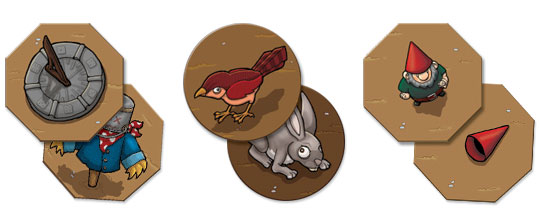
We commonly used the phrase “optimize your pips” during the game. If you’re not familiar with the term, “pips” are the dots on the dice. This will make more sense when we explain what the sundial and gnome do:
The sundial gives you “up to two imaginary pips to add or subtract from coordinate-creating dice.” For example, if you roll two fours, you could use the two pips to change the dice to two fives.
The gnome gives you up to two imaginary pips to add or subtract from dice used for buying seeds, watering seeds and/or harvesting veggies. For example, you could change a three to a five and buy a more expensive veggie.
A couple words of advice… if you don’t play one or both of these tiles, then you’re going to have a really hard time winning. Also, if you’re going to play them, play them early to get the most benefit!
For the most part, the garden is a peaceful place, but if you want a more aggressive game you can play the bird/rabbit tile. You can then use your dice to move the bird or rabbit onto another player’s seed or veggie and either eat it (removing it from the game), or steel it (the bird eats seeds, the rabbit eats veggies).
In defense of the bird/rabbit, you can flip a sundial over (when you play the tile you must play it sundial side up first) to the scarecrow side. What’s cool about the scarecrow is that not only will it protect your seeds that are adjacent to it, but it will also give you 3 bonus points for each of your veggies that you harvest that are adjacent to it, so it’s a win/win!
Scoring
In terms of bonus points, the corner of the garden with the point multipliers (doubles the points you get for harvesting) is a great way to get a lot of points. The thing to note though is that it’s not easy to roll those coordinates, and even when you do, it’s very likely someone else will have their veggies there (this is why you NEED the sundial!).
The game ends when all the seeds from the supply have been purchased. Look out if you’ve got a bunch of purchased but unplanted seeds at the end of the game because you’ll take a -5 point penalty for each unplanted seed beyond the first.
Now each player looks at the veggies they’ve harvested to see if they get bonus points. You get bonus points for each complete set of 5 different veggies you have, as well as for collections of 3,4 or 5 of the same type of veggie. Finally, if you didn’t use your sun token you’ll get an additional 5 bonus points.
Components
The components in Garden Dice are all top notch. The tiles and tokens are nice and thick. The illustrations and layout of the game are very well done and fit perfectly with the theme. There are also very informative reference boards that you can give each player. These boards show what you can do on your turn, explain the special tile actions and how the scoring works at the end of the game.

Learning Curve
The rules are quick to read and straight-forward. Teaching this game is a breeze.
Who would enjoy this game?
Final Thoughts
Garden Dice brings some unique mechanics to the table, and the ability to further manipulate your dice rolls is a huge plus that makes the game more approachable to a wider range of gamers. The game does play a bit differently based on how many people are playing, but it can be fun to adapt your strategy based on this. If you’ve played Settlers of Catan, it’s basically the same thing where the more players there are, the more crowded the board gets, and the harder it is to get what you want before someone else takes it!
Garden Dice is a good game to pull out with family and friends in a more casual setting. Although the age on the box says 10+, we could easily see this being played with younger children that know, or are learning, their numbers. Because there are a lot of options to take with the dice you roll, you’ll need some patience if you’re playing with young children.
With great production value, easy to learn rules and unique dice rolling mechanics, Garden Dice is definitely a game to consider adding to your collection!
User Reviews (1)
Add a Review for "Garden Dice"
You must be logged in to add a review.


KEY POINTS:
-In a game based on dice rolls, Garden Dice brings quick play and light strategy to the table as players try to collect more points than their opponent(s) in the form of harvested veggies.
-With the addition of special tiles to modify die results, strategy can trump the inherent luck factor.
-Works best with 3-4 players, but a 2-player game can be very satisfying.
GAMEPLAY:
The gameplay is described very well in the BG Review, so I will not be covering that component in detail.
I did, however, want to touch on the marvelous gold mine of balance that exists between the luck and strategy factors in this game. While players are rolling dice to use for purchasing, coordinate placement, watering, and harvesting, the existence of specific special tiles (the sundial and gnome) allow a player to modify these die results to a certain degree, giving players the ability to maximize how their dice can be used. This means that even relatively bad dice rolls won’t break a player’s strategy.
Tile placement can be crucial to getting the most points for your crops and in terms of how much effort a player needs to exert to water and harvest crops.
The game limits the number of tiles that are in play at once, so players have to carefully plan out their tile placement.
Players also have the option to include more aggressive tactics with the ability to consume planted seed/veggie tiles, which can definitely lead to more player interaction than is otherwise experienced. The rules do limit a player from attacking another player more than once per round, so players cannot devastate another’s crops in a single turn.
The game plays well with two players, but the board will feel emptier and have far fewer interactions than during a three or four-player game since all share the same gardening space. An additional tile each (a rock) is provided in two player games, but does not have much added value to the game other than taking up space and blocking bird and rabbit movement.
The Last Harvest (or How the Game Ends):
Once the last seed tile is purchased, that player (and only that player) finishes his turn and ends the game. This may seem rather abrupt, so it is worth mentioning that a house rule to allow all other players to take one final turn may be warranted. This will also inevitably affect scoring, giving players a much-needed chance to clear out any unplanted crops to avoid scoring penalties.
Play time changes considerably with the number of players in the game. Each player adds about 10-15 minutes of play time, though new players will likely take longer.
COMPONENTS:
Beautiful artwork and top quality components (thick stock and wooden pieces) suggest that this game will last for a while and look good doing it. I found that the box insert is not terribly efficient at managing the game contents. With much hesitation I found that discarding it and utilizing small baggies was far more useful in keeping the box organized and compact.
RULES:
Weighing in at eight pages (with plentiful illustrations), the rulebook is a clear and concise read, though a bit lengthier than one might expect for a dice-rolling game with a fair helping of strategy. However, the rules include examples to clear up possible points of confusion. Teaching this game to new players will be relatively easy, but there are more than a few minor rules that might trip up newer players. Scoring, in particular, should be discussed in detail so players can plan out their strategies accordingly.
REPLAY FACTOR:
Garden Dice doesn’t bring a lot of variety in terms of different scenarios or a multitude of component options. However, what it lacks in those categories it makes up for in elegantly simple strategies and random dice rolls. Families and casual gaming groups will find it appealing and will come back for more as they strive to out-roll, out-wit, and out-garden their opponents each time they play.
PROS:
-Quick turn play with simple mechanics.
-Well-explained rules with illustrations.
-Garden-themed, eye-catching cartoonish artwork.
-High quality components.
-Quick set up time.
-Easy enough for kids to learn, but with enough back-and-forth play to hold adult attention spans.
-Unique tile abilities can compensate for some bad dice rolls.
CONS:
-May have a few too many rules to be a good gateway game.
-Regular poor dice rolls could leave players struggling to get the best results.
SUMMARY:
Garden Dice is a light-hearted and fun game that brings just enough strategy to bear with an otherwise luck-based dice-rolling game. The turns pass quickly and with some noted apprehension as the coveted board spaces quickly fill up, the seed supply dwindles, and the end of the game draws ever closer. Will another player sabotage your veggies or sneak theirs next to you to freeload from your efforts? My group found ourselves enjoying this delightful game and wanting more rounds of play. Dig in!